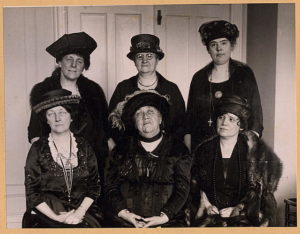Tales from
Pioneers and Soldiers Memorial Cemetery
By Sue Hunter Weir
169th in a Series

Photo courtesy of Atchison Family
The photo was taken in 1920 when the women shown in the photo were the first women to serve on the Executive Committee of the nation-wide Republican Party. Carrie Fosseen, suffragist and social reformer (second row, far right) was a long-time resident of what is now the Phillips Community.
Carrie Jorgens Fosseen is not buried in Layman”™s Cemetery but this month, on the 100th anniversary of Minnesota”™s ratification of the 19th amendment, she is well worth taking the time to remember.Â
She was a suffragist, a social reformer, and political activist, and for the many years she lived in what is now Phillips.
Carrie and her husband, Manley Fosseen, lived at 2916 Bloomington Ave. between 1900 and 1920, in a house that still stands. Although they would not have been considered wealthy, they had enough money that Carrie was able to devote a great deal of her time advocating for those who had much less.Â
For her efforts on behalf of suffrage, Carrie was one of the first women appointed to the Executive Committee of the national Republican Party. In 1920, eight million new voters, all women, were about to vote for the first time, and both of the major parties had a stake in courting them.
But that appointment capped almost 20 years of her activism and advocacy on behalf of a number of causes. She, like many other middle-to-upper-middle-class progressive women spent countless hours lobbying politicians who they could not vote for. Women”™s clubs and organizations banded together and did what they were exceptionally good at ”“ organizing around issues that affected women and children, and fundraising in support of those causes.
She was president of the Thomas Hospital Tubercular Society, and of Tag Day, a fundraiser for the city”™s visiting nurse program that provided in-home medical care to those who could otherwise not afford it. She chaired the “Sane Fourth” Committee, an organization that tried to prevent blindness, amputations and death caused by the reckless use of fireworks on the Fourth of July, something that might sound frivolous today but was a very serious problem at the time.Â
She was an active member of the most well organized and most effective organization of its kind ”“ the Minneapolis Women”™s Welfare League, a political offshoot of the Minneapolis Women”™s Club. Founded in 1912, its mission was “the promotion of the welfare of women and girls.” At the time, there were an estimated 4,000 “homeless girls” in Minneapolis. They did not use “homeless” in the same sense that we do today but used it to describe girls and young women who did not live with family or friends. Then, as today, there was a serious shortage of affordable housing and only 22% of those women had adequate housing; the rest were thought to be vulnerable to sex traffickers. The sad fact was that sex work paid better than factory work.
That reality led the League to take up the cause of poor women, many of them immigrants. The League established a residence for 200 young women complete with a dining room, auditorium and moving picture theater. They lobbied the School Board for vocational education for girls similar to the programs offered to boys. They opened a vacation home in Prescott, Wis. where a $3 fee covered the cost of a week”™s room and board and train fare to and from Minneapolis. And they ran a Rest and Convalescent Home at 2925 Park Ave. for women who had been discharged from hospitals but who had nowhere to go and no one to care for them.
Carrie was 45 years old when she cast her first vote in a presidential election. Although many of Carrie”™s political views were progressive, they were by no means radical. She voted for Warren G. Harding, a man she believed to be a friend to labor, a constituency near and dear to the Fosseens”™ hearts.Carrie”™s husband, Manley L. Fosseen had served 12 years in the Minnesota state legislature serving the 42nd District (ours) that was home to thousands of skilled blue-collar workers and described as the “strongest labor district in Minnesota.” Â
Republicans had high hopes for a Harding administration but those came to an end when he died unexpectedly after only two years in office. Scandals that came to light after he died left him with the reputation of having been one of the worst presidents in American history.
Undaunted, Carrie remained active in the Republican Party and served on its Executive Committee for 20 years, traveling throughout the Midwest leading planning and strategy sessions for Republican women.
In 1947, she was named Minnesota”™s Mother of the Year which seems somewhat odd for a woman who was so well known for her accomplishments on the national political scene. But it would have been more or less expected that in order to be considered successful, a woman of her generation would have had to be able to balance her political ambitions with her domestic life. And she did that. She accomplished all that she did while raising two sons, and, following the death of one of them, raising two of her grandchildren. Â
Carrie Fosseen died on March 23, 1963, at the age of 88. She is buried next to her husband in Lakewood Cemetery.














